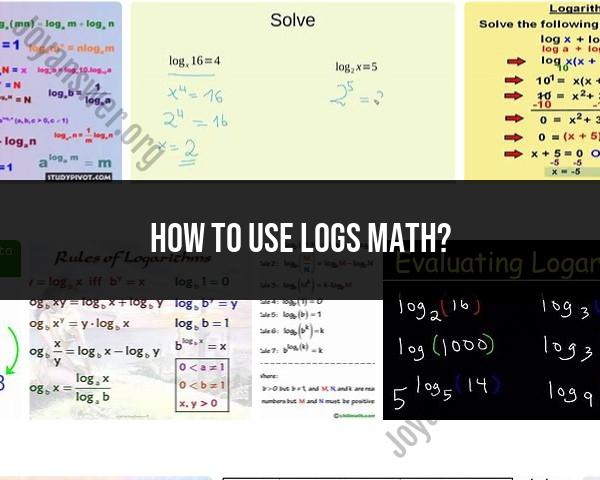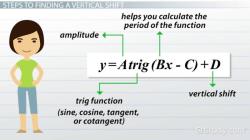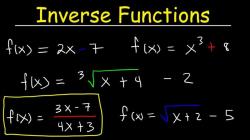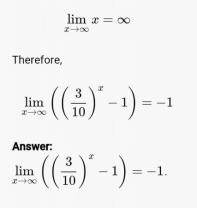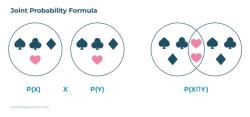How to use logs math?
Logarithms (logs) are a valuable mathematical tool used in various mathematical and scientific contexts to simplify calculations, solve equations, analyze data, and express relationships between numbers. Here are some common ways to use logarithms in mathematics:
Solving Exponential Equations:
- Logarithms can be used to solve equations involving exponential functions. For example, to solve for x in the equation 2^x = 16, you can take the logarithm of both sides: log(2^x) = log(16). Using the property of logarithms, x * log(2) = log(16), and then solve for x: x = log(16) / log(2).
Expressing Large and Small Numbers:
- Logs are used to express very large or very small numbers more conveniently. For example, instead of writing 1,000,000, you can express it as log(10^6) = 6.
Measuring Growth and Decay:
- Logarithms are used to analyze exponential growth and decay. For instance, the half-life of a substance can be calculated using the formula t = (ln(2)) / k, where "t" is the half-life, "ln" is the natural logarithm, and "k" is the decay constant.
Data Transformation:
- In statistics, logarithmic transformations are used to stabilize the variance and make data more normally distributed, which is helpful in regression analysis and other statistical techniques.
Calculating Compounded Interest:
- Logarithms are used to calculate interest rates and time periods in compound interest problems, such as the compound interest formula A = P(1 + r/n)^(nt), where "r" is the annual interest rate and "t" is the number of years.
Solving for the Time Period in Financial Models:
- Logarithms are used in financial models to solve for the time period "t" in equations like A = P * e^(rt), where "A" is the final amount, "P" is the principal, "r" is the interest rate, and "t" is the time.
Signal Processing:
- Logarithms are used in signal processing and audio engineering to represent the magnitude of signals on a logarithmic scale, such as in decibels (dB).
Measuring Sound Intensity:
- The decibel (dB) scale is a logarithmic scale used to measure sound intensity, where the dB level is calculated as 10 times the logarithm of the ratio of two sound intensities.
Computer Science:
- Logarithms are used in computer science and algorithms to analyze the time complexity and performance of algorithms, often expressed as "O(log n)" for logarithmic time complexity.
Geometric Scaling:
- Logarithmic scales are used in various graphical representations to show data that spans multiple orders of magnitude, such as the Richter scale for measuring earthquake magnitudes.
Understanding how and when to use logarithms in mathematics is essential for solving various problems, especially those involving exponential growth, decay, and large numerical scales. Logarithms are a powerful tool for simplifying complex calculations and modeling various phenomena.
How to use logarithms (logs) in mathematical calculations and problem-solving?
Logarithms are used in a variety of mathematical calculations and problem-solving. Here are a few examples:
- Solving exponential equations: Logarithms can be used to solve exponential equations, such as the equation 2^x = 100. To solve this equation, we can take the logarithm of both sides of the equation and use the following property of logarithms:
log(a^b) = b * log(a)
log(2^x) = log(100)
x * log(2) = log(100)
x = log(100) / log(2)
Therefore, the solution to the equation is x = 6.643.
- Calculating compound interest: Logarithms can be used to calculate compound interest. Compound interest is interest that is earned on both the principal amount and the accumulated interest. The following formula can be used to calculate compound interest:
A = P(1 + r/n)^(nt)
where:
- A is the accumulated amount
- P is the principal amount
- r is the interest rate
- n is the number of compounding periods per year
- t is the number of years
The logarithm of the accumulated amount can be used to solve for the exponent in the above formula. This can be useful for calculating the number of years required to reach a certain goal, such as retirement savings.
- Calculating pH levels: Logarithms can be used to calculate pH levels. pH is a measure of the acidity or basicity of a solution. The following formula can be used to calculate pH:
pH = -log(H+)
where H+ is the concentration of hydrogen ions in the solution.
These are just a few examples of how logarithms can be used in mathematical calculations and problem-solving. Logarithms are a powerful tool that can be used to solve a variety of problems in mathematics and science.
What are the practical applications and uses of logarithms in mathematics and science?
Logarithms have a wide range of practical applications in mathematics and science. Here are a few examples:
- In mathematics, logarithms are used in a variety of calculations, such as solving exponential equations, calculating compound interest, and calculating pH levels.
- In physics, logarithms are used to calculate decibel levels and to describe the relationship between frequency and amplitude of sound waves.
- In chemistry, logarithms are used to calculate pH levels and to describe the relationship between concentration and acidity of solutions.
- In biology, logarithms are used to calculate population growth rates and to describe the relationship between dose and response of drugs.
- In economics, logarithms are used to calculate compound interest and to describe the relationship between inflation and purchasing power.
These are just a few examples of the many practical applications of logarithms in mathematics and science. Logarithms are a powerful tool that can be used to solve a variety of problems in the real world.
How to employ logarithmic functions for data analysis and modeling?
Logarithmic functions can be used for data analysis and modeling in a variety of ways. Here are a few examples:
- Logarithmic functions can be used to fit trend lines to data. This can be useful for identifying trends in data and for making predictions.
- Logarithmic functions can be used to model exponential growth and decay. This can be useful for modeling the spread of disease, the growth of populations, and the decay of radioactive isotopes.
- Logarithmic functions can be used to model logarithmic relationships. For example, the relationship between the intensity of sound and the decibel level is logarithmic.
Here are some specific examples of how logarithmic functions can be used for data analysis and modeling:
- A researcher might use a logarithmic function to model the growth of a population of bacteria. This information could then be used to develop strategies to control the spread of the bacteria.
- A financial analyst might use a logarithmic function to model the growth of a company's stock price. This information could then be used to make investment decisions.
- An engineer might use a logarithmic function to model the relationship between the intensity of sound and the decibel level. This information could then be used to design noise-reducing headphones or earplugs.
Logarithmic functions are a powerful tool that can be used for data analysis and modeling in a variety of ways. By understanding the properties of logarithmic functions and how they can be used, you can gain valuable insights into data and make informed decisions.
